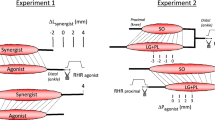Summary
The model of tendon organ activation proposed by Houk and Henneman (1967) has been tested by considering two of its implicit predictions: (1) that only a select group of motor units within a muscle can provide an adequate stimulus to a given tendon organ; and (2) that due to the presence of motor units that can “unload” a given tendon organ, its response to whole muscle contraction can be less vigorous than that to contraction of just the excitatory motor units alone. Tendon organ afferents from the soleus muscle of the cat were functionally isolated from dorsal root filaments. The L7 and S1 ventral roots were split into 25 to 50 “natural” subdivisions, each of which was stimulated at 50 to 100 Hz for 1.5 s. The subdivided filaments were segregated into two groups; those which when stimulated elicited discharge from the Ib afferent (“excitatory” filaments) and those which did not (“non-excitatory” filaments). In ten of eleven experiments, it was found that when all the excitatory filaments were separated out, concurrent stimulation of all the non-excitatory filaments failed to excite the tendon organ, even when these filaments generated over 90% of the muscle's peak tetanic tension. The response of a tendon organ to stimulation of just its excitatory filaments often exceeded its response to whole muscle stimulation. However, several exceptions to this finding were observed, indicating that some tendon organs are affected by “off-line” forces. In general, the present results lend strong support to the Houk and Henneman model.
Similar content being viewed by others
References
Barker D (1974) Morphology of muscle receptors. In: Hunt CC (ed) Handbook of sensory physiology. Springer, Berlin Heidelberg New York (vol III/2, pp 1–190)
Binder MD, Kroin JS, Moore GP, Stuart DG (1977) The response of Golgi tendon organs to single motor unit contractions. J Physiol (Lond) 271: 337–349
Binder MD, Stuart DG (1980) Motor unit-muscle receptor interactions: design features of the neuromuscular control system. In: Desmedt JE (ed) Spinal and supraspinal mechanisms of voluntary motor control and locomotion. Karger, Basel (Prog Clin Neurophysiol, vol 8, pp 72–98)
Binder MD (1980) Further evidence that the Golgi tendon organ monitors the activity of a discrete set of motor units within a muscle. Neurosci Abstr 6: 217
Bridgeman CF (1970) Comparisons of structure of tendon organs in the rat, cat, and man. J Comp Neurol 138: 369–372
Burke RE, Tsairis P (1973) Anatomy and innervation ratios in motor units of cat gastrocnemius. J Physiol (Lond) 234: 749–765
Dutia MB, Ferrell WR (1980) The effect of suxamethonium on the response to stretch of Golgi tendon organs in the cat. J Physiol (Lond) 306: 511–518
Fukami Y, Wilkinson RS (1977) Responses of isolated Golgi tendon organs of the cat. J Physiol (Lond) 265: 673–690
Gregory JE, Proske U (1979) The responses to Golgi tendon organs to stimulation of different combinations of motor units. J Physiol (Lond) 295: 251–262
Houk JC, Henneman E (1967) Responses of Golgi tendon organs to active contractions of the soleus muscle of the cat. J Neurophysiol 30: 466–481
Houk JC, Singer JJ, Henneman E (1971) Adequate stimulus for tendon organs with observations on mechanics of ankle joint. J Neurophysiol 34: 1051–1065
Houk JC, Crago PE, Rymer WZ (1980) Functional properties of the Golgi tendon organs. In: Desmedt JE (ed) Spinal and supraspinal mechanisms of voluntary motor control and locomotion. Karger, Basel (Prog Clin Neurophysiol, vol 8, pp 33–43)
Jami L, Petit J (1976) Heterogeneity of motor units activating single Golgi tendon organs. Exp Brain Res 24: 485–493
Reinking RM, Stephens JA (1975) An interface unit for on-line measurements of motor unit properties with a small laboratory computer. Am J Physic Med 59: 186–193
Reinking RM, Stephens JA, Stuart DG (1975) The tendon organs of cat medial gastrocnemius: significance of motor unit type and size for the activation of Ib afferents. J Physiol (Lond) 250: 491–512
Stauffer EK, Stephens JA (1975) The tendon organs of cat soleus: static sensitivity to active force. Exp Brain Res 23: 279–291
Stephens JA, Reinking RM, Stuart DG (1975) Tendon organs of cat medial gastrocnemius: responses to active and passive forces as a function of muscle length. J Neurophysiol 38: 1217–1231
Stuart DG, Mosher CG, Gerlach RL, Reinking RM (1972) Mechanical arrangement and transducing properties of Golgi tendon organs. Exp Brain Res 14: 274–292
Author information
Authors and Affiliations
Additional information
Supported by National Institutes of Health Grant NS 15404, Teacher-Investigator Development Award NS 00345 from the NINCDS, Biomedical Research Support Grant RR 05432, and Graduate School Research Funds from the University of Washington
Rights and permissions
About this article
Cite this article
Binder, M.D. Further evidence that the Golgi tendon organ monitors the activity of a discrete set of motor units within a muscle. Exp Brain Res 43, 186–192 (1981). https://doi.org/10.1007/BF00237762
Received:
Issue Date:
DOI: https://doi.org/10.1007/BF00237762




